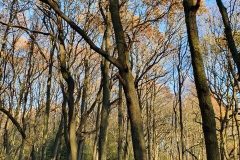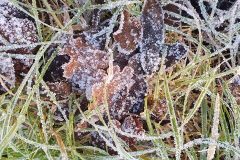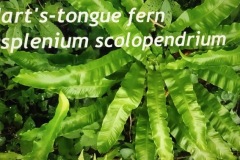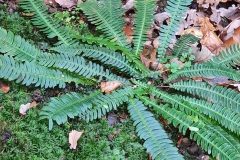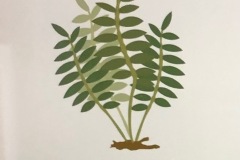Sandall Beat Wood : Friday 9th December 2022
Leader : Jim Burnett
Present throughout: JB, TK, LB and NB. Arriving late, doing his own walk and meeting us almost back at the car park: Colin Howes (see his notes below).
This was advertised as a Winter’s walk so it was appropriate that following a mild November the walk happened on the third day of freezing temperatures. It was a glorious Winter’s day with heavy frost in places and not a cloud in the sky when four members , one of whom, Tom Kohler, had management responsibility for the site in a previous job.
There were many drainage ditches in the wood and a small area of wet fen/reed bed. Tim reported that as late as the 1990’s these were normally filled with water. This is now very rare and there was almost no evidence of standing water. This contrasted with a reconnaissance walk I made 4 weeks earlier with Louise Hill and Tim Prosser following a day of almost continuous heavy rain. Then the dykes were filled but the water had all gone by the 9th of December.
The main botanical interest is probably the ferns. The following were noted (thanks to Louise who previously identified them), Male Fern, Broad Buckler Fern, Hard Fern, Bracken, Hart’s tongue and also in a ditch in the south side of the wood, Soft Shield Fern and probably Golden Scales Male Fern( Dryopteris affinis. The location of one example of Hart’s tongue fern growing on a brick surround to a culvert was noted for the Wall Fern project Colin Howes is carrying out.
I gave the group an explanation as to how to determine whether or not a fern was 1 pinnate, 2 pinnate or three pinnate, a characteristic used in the identification of species.
We arrived back and the car park around 12.30 when Colin generously offered to buy everyone Fish and Chips (accepted by N.B. and J.B. ) Could this be a new tradition-if you arrive late you have to buy Fish and Chips for the rest?
Jim Burnett
Additional notes from Nora Boyle.
Where the sun had penetrated the wood there was no sign of frost and the sky was a clear blue – see photo below
However as Jim says in a few sheltered spots the woodland floor was still frozen, as you can see in this photograph
Jim explained to the group how to determine whether or not a fern was 1 pinnate, 2 pinnate or three pinnate, a characteristic used in the identification of species ( referring to the number of times the fronds are divided ) . ( Hart’s tongue ferns have undivided fronds ) See below.
Hard fern, shown below in a photograph taken last year in the wood, is an example of a fern which is 1 pinnate, meaning the fronds are only divided once.
He also pointed out that most ferns we found grew in a shuttlecock formation, the fronds emerging straight from the ground contrasting with the most common of the ferns , bracken, where fronds emerge from the stipe ( stalk ). See below : Diagrammatic appearance of fern with shuttle cock formation.
Most of the ferns we found were wintergreen, keeping their foliage green most of the year, the exception being bracken which turns brown in the autumn.
Nora Boyle
Additional notes from Colin Howes
A bitterly cold but sunny and still day.
Grey Squirrels were seen foraging in leaf litter on the ground and taking refuge up tree trunks when dog walkers passed by. The leaf-fall and still, bright conditions rendered the ball-shaped squirrel drays easily visible in their very elevated tree canopy positions. Their frequent occurrences suggested the prospect of a future Nats survey of their numbers, distribution, height and tree species choice.
Birds seemed relatively infrequent. Perhaps the most active and numerous were Wood Pigeons. The odd Carrion Crow was keeping a look-out from tree-top vantage points and a group of Jackdaws were quite vocal in the vicinity of the Wood House and adjacent recreation ground.
A foraging group of small birds consisting of Great and Coal Tits (3) and a Robin was busy by the mineral line to the south-west of the Wood House.
Perhaps the highlights were (a) two calling Nuthatches in the old tree canopies in the woodland sector between Cross Riding and Wood’s Riding and (b) a huge bracket fungus (possibly a Ganoderma sp.) growing from the base of a dead Beech trunk by Fores Drain, overlooking Cantley Park sports grounds.
The visit suggested the possibility of a Spring/Summer visit to the adjacent landscaped Armthorpe Colliery tip.
CAH.
